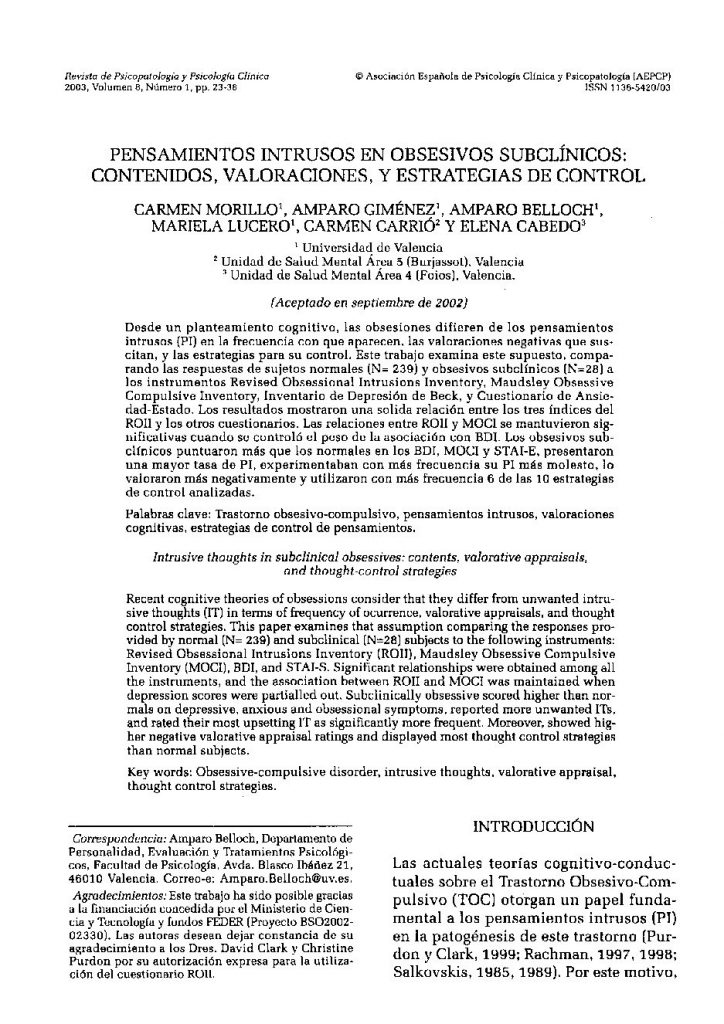Pensamientos intrusos en obsesivos subclínicos: Contenidos, valoraciones, y estrategias de control.

- Cuestionarios, inventarios y escalas de ansiedad social para adolescentes: Una revisión crítica.
- Pensamientos intrusos en obsesivos subclínicos: Contenidos, valoraciones, y estrategias de control.
- Cuestionario de Afrontamiento del Estrés (CAE): Desarrollo y validación preliminar.
- La prevención del burnout en las organizaciones: El chequeo preventivo de Leiter y Maslach (2000).
- Protocolo de las sesiones de terapia interpersonal aplicada a un grupo de familiares de pacientes con trastorno de conducta alimentaria.
- Cristina Botella, Rosa M. Baños y Conxa Perpiñá (Eds.)(2003): Fobia Social. Avances en la psicopatología, la evaluación y el tratamiento psicológico del trastorno de ansiedad social. Barcelona: Paidós.
- Diana Kirszman y M. Carmen Salgueiro (2002): El enemigo en el espejo: De la insatisfacción corporal al trastorno alimentario. Madrid: TEA Ediciones.
Recent cognitive theories of obsessions consider that they differ from unwanted intrusive thoughts (IT) in terms of frequency of ocurrence, valorative appraisals, and thought control strategies. This paper examines that assumption comparing the responses provided by normal (N= 239) and subclinical (N=28) subjects to the following instruments: Revised Obsessional Intrusions Inventory (ROII), Maudsley Obsessive Compulsive Inventory (MOCI), BDI, and STAIS. Significant relationships were obtained among all the instruments, and the association between ROII and MOCI was maintained when depression scores were partialled out. Subclinically obsessive scored higher than normals on depressive, anxious and obsessional symptoms, reported more unwanted ITs, and rated their most upsetting IT as significantly more frequent. Moreover, showed higher negative valorative appraisal ratings and displayed most thought control strategies than normal subjects.
Desde un planteamiento cognitivo, las obsesiones difieren de los pensamientos intrusos (PI) en la frecuencia con que aparecen, las valoraciones negativas que suscitan, y las estrategias para su control. Este trabajo examina este supuesto, comparando las respuestas de sujetos normales (N= 239) y obsesivos subclínicos (N=28) a los instrumentos Revised Obsessional Intrusions Inventory, Maudsley Obsessive Compulsive Inventory, Inventario de Depresión de Beck, y Cuestionario de Ansiedad-Estado. Los resultados mostraron una solida relación entre los tres índices del ROII y los otros cuestionarios. Las relaciones entre ROII y MOCI se mantuvieron significativas cuando se controló el peso de la asociación con BDI. Los obsesivos subclínicos puntuaron más que los normales en los BDI, MOCI y STAI-E, presentaron una mayor tasa de PI, experimentaban con más frecuencia su PI más molesto, lo valoraron más negativamente y utilizaron con más frecuencia 6 de las 10 estrategias de control analizadas.



